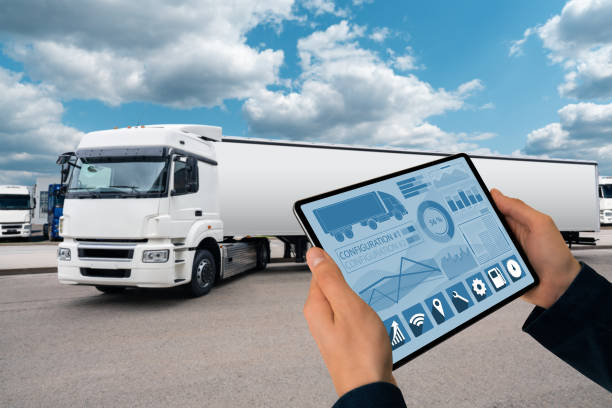Hello!
 Artificial Intelligence (AI), which is used in fleet management, dramatically improves the efficiency of transportation companies. Combining machine learning and AI, AI uses data from driver learning patterns to make tailored predictions. Barrett Young, SVP of Marketing at Netradyne shares how fleets can harness technology to improve and automate their decisions, increase driver safety and decrease vehicle downtime.
Artificial Intelligence (AI), which is used in fleet management, dramatically improves the efficiency of transportation companies. Combining machine learning and AI, AI uses data from driver learning patterns to make tailored predictions. Barrett Young, SVP of Marketing at Netradyne shares how fleets can harness technology to improve and automate their decisions, increase driver safety and decrease vehicle downtime.
Transport companies have started to realize the benefits of Artificial Intelligence. This includes reducing risk in the cab and the road, managing costs better and improving compliance. Predictive analytics, Machine Learning (ML), Predictive Analytics, and Computer Vision-based automated communications are some of the main uses of AI to power fleet operations.
This technology makes roads safer, enhances safety culture, modernizes trucking, and improves efficiency. Fleet managers can use the data provided by AI solutions to make more informed decisions in order to improve driver safety, track costs, and monitor fleet operations.
Safety of the Drivers and Vehicles is a Priority
Fleets can detect dangerous driving behaviors and common violations such as speeding, distracted driving, and driver fatigue using an AI-powered fleet safety program. Fleet managers can gain insight into the performance of drivers and track areas where they need to be improved or rewarded.
 Video safety systems can recognize these risky driving behaviors:
Video safety systems can recognize these risky driving behaviors:
- Distracted driving
- Distance to other vehicles
- Breezing hard
- Accelerating
Without a reliable safety system that provides real-time information to identify potential risks, fleet managers can’t accurately assess the driving skills of drivers. AI-powered video safety systems can detect dangerous driving habits and alert drivers immediately to correct them. The AI-powered dash camera will not only alert drivers when corrections are needed, but it will also reward safe driving. This helps to create a balanced safety culture.
 Drivers can be notified via in-cab audio to correct unsafe driving habits and warn them about potential accidents. If a driver follows too closely to a vehicle, they will be immediately notified so that they can make corrections.
Drivers can be notified via in-cab audio to correct unsafe driving habits and warn them about potential accidents. If a driver follows too closely to a vehicle, they will be immediately notified so that they can make corrections.
A fleet manager can review the video and call the driver to correct their driving at any time. Trucking businesses can communicate more easily with drivers and track their vehicle usage, which improves their proof of liability and workflow.
Fleet managers must be able to access reliable data quickly in order to fight insurance claims, keep drivers compliant, and assist them when an accident happens. Machine learning can sort through large amounts of data to help drivers and managers understand the cause and impact of an incident. ML-based dash cameras also learn from driver behavior to predict risks around their vehicle. They identify and monitor road signs and follow distances.
Improved Vehicle Maintenance Tracking
AI-based technology uses data to make predictions and gain insight. These data-driven forecasts help to identify the potential wear and tear of fleet vehicles. Fleet managers will be able to quickly access this data and pinpoint the driving habits that have long-term detrimental effects on their vehicles.
 Edge computing allows dash cams to respond in real-time with very little lag. It is possible to access large amounts of data quickly from remote locations. Edge computing allows data to be processed quickly without needing to be sent to the cloud. This adds an additional layer of security. Modern fleet vehicles have a multitude of electronic parts and sensors. These collect information about the fuel consumption, location, vehicle usage, driving hours, and other factors.
Edge computing allows dash cams to respond in real-time with very little lag. It is possible to access large amounts of data quickly from remote locations. Edge computing allows data to be processed quickly without needing to be sent to the cloud. This adds an additional layer of security. Modern fleet vehicles have a multitude of electronic parts and sensors. These collect information about the fuel consumption, location, vehicle usage, driving hours, and other factors.
AI can predict problems and detect over-exertion points. Examples include AI-powered camera systems that monitor tire tread and provide evidence of theft. The Internet of Things (IoT), predictive maintenance, data analytics and data analytics all improve vehicle care efficiency. These systems help trucking companies to better manage their vehicle maintenance costs.
Reliable Data has Many Benefits
Fleets use AI to improve decision-making based on a variety of data types. This data is generated by learning the behavior of individual drivers as they perform their jobs. This score is used to determine areas where the driver is improving or displaying risky driving behaviors. This could be the case when AI-powered technology detects that a driver is turning at high speeds. This data can be accessed by fleet managers to arrange training for the driver. Drivers can also receive customized coaching to improve their skills and create safer roads.
 Data provided by AI can help to measure vehicle maintenance issues such as fuel consumption. To pinpoint potential problems, data can be gathered from driver behavior, road conditions, and vehicle operation during service hours. Similar to how driver data can be learned over time, making it more personalized, vehicle data can be used to make better predictions about when and how often a vehicle should be serviced. This technology improves decision-making and saves time and energy for trucking businesses.
Data provided by AI can help to measure vehicle maintenance issues such as fuel consumption. To pinpoint potential problems, data can be gathered from driver behavior, road conditions, and vehicle operation during service hours. Similar to how driver data can be learned over time, making it more personalized, vehicle data can be used to make better predictions about when and how often a vehicle should be serviced. This technology improves decision-making and saves time and energy for trucking businesses.
Another way AI improves decision-making and optimizes workflow is virtual coaching. Fleet managers can access driver videos and AI-analyzed in-cab alerts easily. The AI algorithm analyzes the driver’s safety alerts and gives them coaching tasks to improve their behavior. This is done virtually so managers don’t have to spend as much time watching videos and drivers can improve their safety.
Also read:
- The Complete Guide to Venue Selection
- How You Can Apply Flywheel Thinking Model to Your Company’s Budget
- Mastering SEO for Fintech Firms
Safety and Efficiency in Driving
 An AI-powered safety system allows fleets to prioritize safety without having to increase efficiency or risk increasing costs. The use of AI dash cameras for remote coaching can help companies save time and improve driver retention. Fleets can improve driver and vehicle safety, monitor vehicle maintenance, and streamline their work processes by using AI and Machine Learning. The smoothest workflow for fleet managers is possible without compromising the business goals of their drivers and employees.
An AI-powered safety system allows fleets to prioritize safety without having to increase efficiency or risk increasing costs. The use of AI dash cameras for remote coaching can help companies save time and improve driver retention. Fleets can improve driver and vehicle safety, monitor vehicle maintenance, and streamline their work processes by using AI and Machine Learning. The smoothest workflow for fleet managers is possible without compromising the business goals of their drivers and employees.
Thank you!
Join us on social media!
See you!






